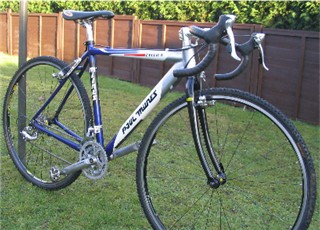

| ' | C | R | O | S | S | B | I | K | E | S |
| Introduction:
Cyclo-cross equipment has substantially improved over recent years, and there are now a wide range of specialist complete
bikes, frames and components on the market to choose from. The main aims when selecting or building a 'cross bike are: To have the lightest possible machine with good clearances, grippy tyres, low gears, and an easy method of changing gear. Sounds like a mountain bike? Well, there is no reason why a mountain bike can't be used in most races, this is a matter of personal choice, however, the majority of riders select a specialist machine, and for anyone wishing to compete in Premier (major) events and the 3 Peaks Cyclo-Cross, there are rules that restrict riders to specific cyclo-cross bikes.     Cantilever brakes |
Good range of gears |
Anti-mud pedals |
Grippy tyres |
| Features of the typical Cyclo-Cross bike Frame: The aluminium frame is now very popular among riders as they are super light, relatavely cheap and there are a wide range specially designed for cyclo-cross now on the market. The main features are that there should be good clearances to prevent mud clogging, and mountings for cantilever brakes. Wheels/Tyres: There aren't any specifically built wheels for cyclo-cross (so far as I know), but a good pair of ordinary roadwheels work fine. As there is now a wide range of 'cross tyres on the market, most riders are opting for 'clincher' rims as opposed to 'sprint' rims and tubular tyres, but its a matter of personal preference. There are advantages and disadvantages of both. Gears: Low gearing is essential for climbing the inevitable steep banks that most courses incorporate. Riders have allsorts of gearing combinations, but something like a 14 to 28 rear cassette and a 40 front ring would probably be around the most common arrangement. Some riders prefer to use a single front chainring with chain guards to stop the chain jumping off, others opt for a double, or triple where there is no need for guards. The most preferred gear changers are nowadays the combined brake/gear levers (STI levers) which conveniently offer indexed gearchanging without need to remove the hands from the bars. The alternative to this is the handlebar-end changer (which everyone used not so long ago!) Pedals: Clipping the feet in and out quickly is an important part of cyclo-cross racing, time can be lost if you don't get them in straight away. The main problem is that once the feet get muddy, this can hamper entry, and the pedals get clogged up. There are lots of different designs of pedal around, but most favoured in 'cross are SPD double sided (also favourite with mountain bikers) but its a case of finding some that have a good 'through passage' for mud and are less likely to clog. Time pedals are also used by some riders successfully, but a recent innovation is the 'egg whisk' pedal by Crank Brothers.. people using them so far think they are great, and they don't suffer from clogging at all. 


 'STI'levers
| triple chainset
| single chainset with guards
| bar-end changer
| Hopefully, this has provided a good insight into what the typical cyclo-cross bike is like, but it's not necessary to have all of this equipment to have a go....any bike will do to get you started- a mountain bike or a touring bike would be ideal. Back to Cyclo-Cross page Back to Cycling Page | |||||||||||||||||||||